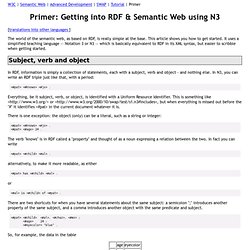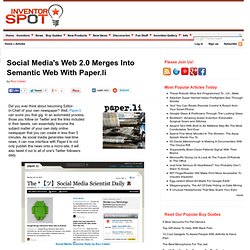

Desktop. Lacantine. Mobile. Nuxeo. CMIS. Bmj. Plone. Forum. Web sémantique » Le web sémantique pour les nuls. Primer - Getting into the semantic web and RDF using N3. [translations into other languages ] The world of the semantic web, as based on RDF, is really simple at the base.

This article shows you how to get started. It uses a simplified teaching language -- Notation 3 or N3 -- which is basically equivalent to RDF in its XML syntax, but easier to scribble when getting started. Web 3.0 and semantic web applications in the public sector #govweb3 - Social Matters. 1. Métadonnées — Éducnet. Préfixe "meta" Du grec "meta" Ce qui dépasse, englobe un objet, une science.

Currently without a clever subtitle. Practical Semantics Seminars in Brussles, Leipzig and Utrecht. Social Media's Web 2.0 Merges Into Semantic Web With Paper.li. Did you ever think about becoming Editor-in-Chief of your own newspaper?

Well, Paper.li can score you that gig. In an automated process, those you follow on Twitter and the links included in their tweets, can essentially become the subject matter of your own daily online newspaper that you can create in less than 5 minutes. As social media generates real-time news, it can now interface with Paper.li to not only publish this news onto a micro-site, it will also tweet it out to all of one's Twitter followers daily. Social Media's Web 2.0 Merges Into Semantic Web With Paper.li. Did you ever think about becoming Editor-in-Chief of your own newspaper?

Well, Paper.li can score you that gig. In an automated process, those you follow on Twitter and the links included in their tweets, can essentially become the subject matter of your own daily online newspaper that you can create in less than 5 minutes. As social media generates real-time news, it can now interface with Paper.li to not only publish this news onto a micro-site, it will also tweet it out to all of one's Twitter followers daily. Semantic Web: In Quest for the Next Generation Killer Apps. WebBackplane. Minding the Planet. CFP: Semantic Web Journal - Special Issue on Semantic Web and Reasoning for Cultural Heritage and Digital Libraries.
The Semantic Web, Part V: Getting Ready. This series on the semantic web started with an introduction in Part I.

In Part II, I made the business case for going semantic. Part III focused on complementary technologies. In Part IV, I provided a case study of how one company is already successfully reaping the benefits of the semantic web. In this final post in the series, I’ll take a look at what organizations can do right now to get ready for the semantic web. Note that much hinges on type of organization. The Semantic Web & THE POWER OF PULL » Introduction. How the pull paradigm and the semantic web combine to help businesses face the challenges of the future.

The Problem On the Web today, we see millions of web sites, each of which presents web pages and documents. These are simply electronic versions of the old paper-based ways of doing things: writing checks, filing taxes, looking at menus, catalog pages, magazines, etc. When you search for something on Google, you get a list of web sites that may or may not have what you’re looking for, based on keywords found in the text. You have to look at each one and decide whether it answers your question. Our information infrastructure isn’t scaling up very well at all. The solution to our information problem is the semantic web and the pull paradigm. Integrate disparate data sources with Semantic Web technology. The core Semantic Web technology is RDF, a W3C standard that reduces all data to three-part statements known as triples.

If your data fits into the triple data model and is stored in one of the specialized databases known as triplestores, the advantages of Semantic Web technology are obvious. This doesn't mean, though, that the technology has nothing to offer you if your data is in more traditional formats such as relational databases and spreadsheets. Open source and commercial tools are available to convert data in these formats to triples, giving you an easy way to combine data from multiple sources using different formats. Planète Web Sémantique. Semanticweb.org. Www.semantic-web-journal.net. Exemples d'utilisation de Dbpedia. The Semantic Web, Customer Service, and the Financial World. Yogi Berra once said, “It’s like deja-vu, all over again.”

With regard to new technologies, the same continues to hold true: The technologies themselves might be new, but they are fundamentally addressing old problems. Many of today’s emerging technologies such as cloud computing, SaaS, MDM, and social networks are really attempts to deal with core business issues. These include: Cost Communication Collaboration Data integrity Access to data Network reliability Scale The eternal battle to do more with less And many, many others One lesser-discussed topic is semantic technologies–at least for the time being. Marrying ARML with Linked Data. First of all, since ARML (augmented reality markup language) is based on KML and KML uses „Placemarks“ (which all have corresponding identifiers) as basic entities, these could be identified quite easily via URIs within the W3C Resource Description Framework (RDF).

Another basic concept of KML is „Point“. Geo RDF provides properties like „geo:long“ or „geo:lat“ which express longitude and latitude of a POI and thus makes it possible to uniquely identify certain points on a map using RDF standards. Thus it is possible to map the geo conventions of ARML to the geo conventions of the Semantic Web which are mainly based on Geo RDF. Useit.com: Jakob Nielsen on Usability and Web Design. Why the Semantic Web Will Fail. Don't get too excited by the title.

But I do want to share a few thoughts... It was running through my head just now, the work that we were doing here in Moncton to work on an e-learning cluster. Because I saw that 'cluster building' is still one of the major pillars of NRC's strategy, and I was wondering whether our work would ever be a part of that again. And I was thinking about some of the things that didn't go so well in our first few years. Some companies went under - a couple, before we even talked to them, another, after we were in a project with them. And they weren't interested.
And I thought about where we're right today and where we might be wrong, and why. Semantic Weblogs. How does the emergence of the semantic web change the way we think about information architecture? : block, slab, pillar. Infochimps Twitter Data APIs Get A Refresh. New and updated APIs for Infochimps take some next steps toward expanding developers’ access to structured data and possibly influencing sentiment analytics. How Twitter could beat Google to the semantic web. Vincent Mazenod, aka mazenovi, aka voisin de gennetines.
À la suite d’une formation distillée par l’enthousiaste et sympathique Gautier Poupeau (aka @lespetitescases), gentiment proposée et organisée par le ccsd, je vais tenter de résumer, en quelques posts, ce que j’ai retenu d’un sujet auquel je ne connaissais absolument rien! À savoir : Pour bien commencer il faut se débarasser de fausses idées qui peuvent rendre la compréhension du concept difficile: on parle de sémantique au sens logique du terme et non au sens linguistique. L’objectif n’est pas de faire des recherches en langage naturel, mais plutôt d’organiser l’information pour faciliter la recherche d’ »information utile », c’est à dire avoir un moyen de trouver ce qui nous intéresse, et que ce qui nous intéresse! Pour le moment un humain est capable d’interroger un moteur de recherche afin de trouver ce qui l’intéresse, en triant les résultats qui lui sont retournés.
L'École numérique » Le Web sémantique. Une approche nouvelle de l’accès à l’information pertinente. Deriving meaning from unstructured data with semantic web. The Semantic Web, Linked Data, and Knowledge Organisation. Are You Prepared for the Semantic Web? > James Mathewson is the global search strategy lead for IBM and co-author of Audience, Relevance and Search, Targeting Web Audiences with Relevant Content. He writes regularly for the book's companion blog, writingfordigital.com, from which this article is reprinted. I recorded a four-part podcast series with Kristina Halvorson, moderated by Mike Moran. We had a great time. We talked about the content strategy around created, curated and aggregated content. I wanted to expound on a point in this article, on which I didn’t have time to elaborate during the podcast series.
The Road to the Semantic Web. Written by Alex Iskold and edited by Richard MacManus. John Markoff's recent article in NY Times has generated an interesting discussion about Web 3.0 being the long-promised Semantic Web. For instance, a short post on Fred Wilson's blog had a lot of lengthy comments attempting to define Web 1.0, Web 2.0 and Web 3.0. NUI web researcher shapes the future of semantic search - Irish Innovation News. A researcher based at NUI Galway’s Digital Enterprise Research Institute (DERI) picked up the ‘Best Paper’ award at the influential Web Rules and Reasoning Conference in Bressanone, Italy.
Dr Axel Polleres’ work surrounds a standard query language for the web, entitled SPARQL1.1. This language allows users to ask complex multi-faceted questions when searching the web. The awarded paper 'Redundancy Elimination on RDF Graphs in the Presence of Rules, Constraints, and Queries', emerged from a collaboration with an Austrian University, TU Vienna. It is co-authored by Prof Reinhard Pichler, Sebastian Skritek, and Dr Stefan Woltran. News » SourceCon’s Semantic Search Series: Understanding Semantic. Before we kick off some posts on some of the semantic search engines that are available out there, we felt it was important to break semantic web technology down a little bit and try to show how it actually works.